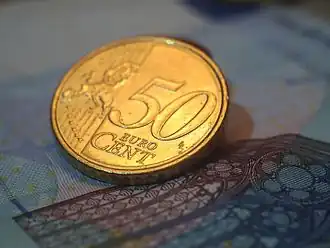Nordic gold

Nordic gold (Swedish: nordiskt guld[1]) is the gold-coloured copper alloy from which many coins are made. Despite the name, it contains no gold, and is a type of aluminium bronze.
History
Nordic gold was developed by Mariann Sundberg while she worked for the Finnish metal company Outokumpu.[2]
Properties
Nordic gold's composition is 89% copper, 5% aluminium, 5% zinc, and 1% tin.[3][4] The colour and density are unlike pure gold, and compared to commercial copper metal, the alloy has significantly smaller grains. A thin oxide material is formed after abrasive polishing.[5] It is hypoallergenic, antimycotic[6] and somewhat antimicrobial (especially after abrasion)[7]. It is also resistant to tarnishing.[8] The European Central Bank says that the alloy is "difficult to melt and used exclusively for coins."[9]
Uses
Nordic gold was originally developed for the 10 Swedish kronor coins in 1991.[10] Many other currencies have also made use of the alloy, most notably in 50, 20, and 10 euro cents.[3][11] Additionally, the 2 Polish złoty commemorative coins.
It has been studied for antimicrobial applications in hospital, to help prevent MRSA infections.[8]
See also
References
- ^ Predecimal.com. "The selection of the alloy for the New Euro Coins". Retrieved 20 March 2020.
- ^ Kuparinen, Tuulikki (19 December 2001). "Kultaiset eurokolikot syntyvät Outokummun kupariseoksesta". Ilta-Sanomat (in Finnish). Retrieved 7 February 2021.
Yhtiön tutkimus- ja kehitysasiantuntija Mariann Sundberg on kehittänyt Nordic Gold -kuparimetalliseoksen
- ^ a b "Brass Material and Specifications Review". Engineer's Edge LLC. Retrieved 14 July 2022.
- ^ "What is Nordic Gold?". European Copper Institute. Retrieved 14 July 2022.
- ^ Chang, Tingru; Wallinder, Inger Odnevall; Jin, Ying; Leygraf, Christofer (2018). "The golden alloy Cu-5Zn-5Al-1Sn: A multi-analytical surface characterization". Corrosion Science. 131: 94–103. Bibcode:2018Corro.131...94C. doi:10.1016/j.corsci.2017.11.014.
- ^ Quaranta, Davide; et al. (January 2011). "Mechanisms of Contact-Mediated Killing of Yeast Cells on Dry Metallic Copper Surfaces". Applied and Environmental Microbiology. 77 (2). American Society for Microbiology: 416–426. Bibcode:2011ApEnM..77..416Q. doi:10.1128/AEM.01704-10. PMC 3020553. PMID 21097600.
- ^ Horton, D.; et al. (2015). "Tarnishing and Cu Ion release In Selected Copper-Base Alloys: Implications Towards Anti-Microbial Functionality". Electrochimica Acta. 169: 351–366. doi:10.1016/j.electacta.2015.04.001. Retrieved 20 March 2020.
- ^ a b Foster, Leanna (13 August 2014). Tarnishing of a Cu-Al-Zn-Sn Alloy Compared to Commercially Pure Copper: Implications Toward Antimicrobial Function (MS thesis). University of Virginia. doi:10.18130/v3q08v.
- ^ "Security features". European Central Bank. 2022.
- ^ Rohrig, Brian (2020). The Chemistry of Money. Royal Society of Chemistry. p. 146. ISBN 9781782629832.
- ^ "Common sides of euro coins". European Commission website. Retrieved 14 July 2022.